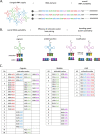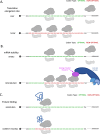Codon optimality in cancer
- PMID: 34584217
- PMCID: PMC8585667
- DOI: 10.1038/s41388-021-02022-x
Codon optimality in cancer
Abstract
A key characteristic of cancer cells is their increased proliferative capacity, which requires elevated levels of protein synthesis. The process of protein synthesis involves the translation of codons within the mRNA coding sequence into a string of amino acids to form a polypeptide chain. As most amino acids are encoded by multiple codons, the nucleotide sequence of a coding region can vary dramatically without altering the polypeptide sequence of the encoded protein. Although mutations that do not alter the final amino acid sequence are often thought of as silent/synonymous, these can still have dramatic effects on protein output. Because each codon has a distinct translation elongation rate and can differentially impact mRNA stability, each codon has a different degree of 'optimality' for protein synthesis. Recent data demonstrates that the codon preference of a transcriptome matches the abundance of tRNAs within the cell and that this supply and demand between tRNAs and mRNAs varies between different cell types. The largest observed distinction is between mRNAs encoding proteins associated with proliferation or differentiation. Nevertheless, precisely how codon optimality and tRNA expression levels regulate cell fate decisions and their role in malignancy is not fully understood. This review describes the current mechanistic understanding on codon optimality, its role in malignancy and discusses the potential to target codon optimality therapeutically in the context of cancer.
© 2021. The Author(s).
Conflict of interest statement
The authors declare no competing interests.
Figures




References
-
- Schwanhüusser B, Busse D, Li N, Dittmar G, Schuchhardt J, Wolf J, et al. Global quantification of mammalian gene expression control. Nature. 2011;473:337–42. - PubMed
-
- Perron G, Jandaghi P, Solanki S, Safisamghabadi M, Storoz C, Karimzadeh M, et al. A General Framework for Interrogation of mRNA Stability Programs Identifies RNA-Binding Proteins that Govern Cancer Transcriptomes. Cell Rep. 2018;23:1639–50. - PubMed
Publication types
MeSH terms
Substances
Grants and funding
LinkOut - more resources
Full Text Sources
Other Literature Sources
Medical
Research Materials

